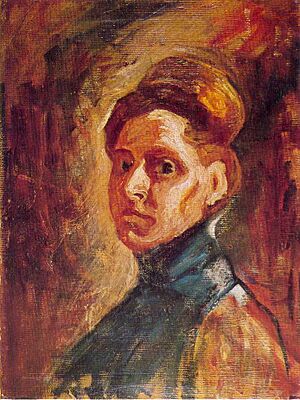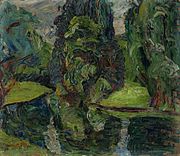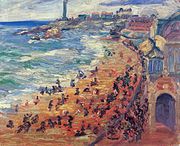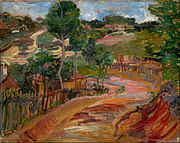Nadežda Petrović facts for kids
Quick facts for kids
Nadežda Petrović
|
|
|---|---|
| Надежда Петровић | |
 |
|
| Born | 11/12 October 1873 Čačak, Principality of Serbia
|
| Died | 3 April 1915 (aged 41) Valjevo, Kingdom of Serbia
|
| Nationality | Serbian |
| Known for | Painting |
| Movement | Fauvism |
| Awards | Medal for Bravery Order of the Red Cross |
Nadežda Petrović (Serbian Cyrillic: Надежда Петровић; 11/12 October 1873 – 3 April 1915) was a very important Serbian painter. She is known as one of Serbia's most famous artists who used styles like expressionism and fauvism. She was also one of the first women to take war photographs in her region. Born in Čačak, Nadežda moved to Belgrade when she was young. She studied art there and later taught it. She also went to Munich, Germany, to study painting further. From 1901 to 1912, her art was shown in many cities across Europe.
Later in her life, Nadežda spent less time painting. She volunteered as a nurse during the Balkan Wars in 1912 and continued helping soldiers until 1913. She even got sick with typhus and cholera. For her brave work, she received a Medal for Bravery and an Order of the Red Cross. When World War I started, she again volunteered as a nurse with the Serbian Army. Sadly, she died of typhus on April 3, 1915.
Her artworks include almost 300 oil paintings, about 100 sketches, and several watercolors. Her art shows different styles like secession, symbolism, impressionism, and fauvism.
Contents
Biography
Early Life and Education
Nadežda Petrović was born in Čačak, Principality of Serbia, on October 11 or 12, 1873. Her parents were Dimitrije and Mileva Petrović. She had nine brothers and sisters, including Rastko Petrović, who became a writer and diplomat. Her mother, Mileva, was a school teacher and related to a famous Serbian politician, Svetozar Miletić. Her father taught art and literature. He also loved collecting artworks and later worked as a tax collector.
In the late 1870s, her father became ill. This made the family move to Karanovac (now Kraljevo). They later moved to Belgrade in 1884. The house they lived in was later destroyed during World War II. Nadežda showed signs of being a talented artist from a young age. She was taught by Đorđe Krstić and went to the women's school of higher education. She finished her studies there in 1891.
Becoming an Artist
In 1893, Nadežda became an art teacher at the same school. She later taught at the women's university in Belgrade. After that, she received a stipend (money given to help someone study) from the Serbian Ministry of Education. This allowed her to study art at a private school in Munich, run by Anton Ažbe. In Munich, she met other painters like Rihard Jakopič and Ivan Grohar. She also met modern art pioneers such as Wassily Kandinsky and Paul Klee. Their work greatly impressed her.
While in Munich, she often wrote letters to her parents in Serbia. She always asked them to send her newspapers and books about what was happening in her home country. Her strong dedication to art affected her personal life. In 1898, she ended her engagement to a civil servant. This happened because the man's mother asked for a very high dowry (a payment from the bride's family), which was too much.
Nadežda returned to Serbia in 1900. She regularly visited museums and galleries and went to concerts and plays. She also spent a lot of time learning foreign languages. Her first solo art show was in Belgrade that same year. She also helped organize the First Yugoslav Art Exhibit and the First Yugoslav Art Colony. In 1902, Petrović started teaching again at the women's school of higher education.
A Patriot and a Nurse
The next year, 1903, Nadežda helped start the Circle of Serbian Sisters. This was a group that helped Serbs living in areas controlled by the Ottoman Empire, like Kosovo and Macedonia. In 1904, Petrović went to her family home in Resnik. There, she focused on her paintings. One of her most famous works, Resnik, was painted during this time.
Over the next few years, she became involved in groups that supported Serbia. She collected help for poor people in Old Serbia and protested against Austria-Hungary taking over Bosnia and Herzegovina. In 1910, she traveled to Paris to visit her friend, the sculptor Ivan Meštrović. She stayed in France until she heard the sad news of her father's death. She returned to Serbia in April 1911. When she came back, she continued teaching at the women's school of higher education. She also showed her artworks as part of the Kingdom of Serbia's display at the International Exhibition of Art of 1911.
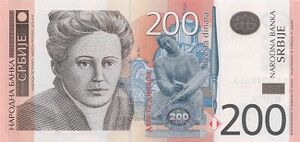
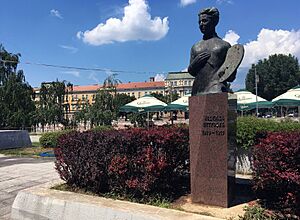
In 1912, Nadežda's mother died. Soon after, the Balkan Wars began. Petrović volunteered to be a nurse. She was given a Medal for Bravery, an Order of St. Sava, and an Order of the Red Cross for her brave work. She kept nursing Serbian soldiers until 1913. During this time, she got sick with typhus and cholera. In her later years, she had little time to paint. She created only a few paintings, including her post-impressionist masterpiece The Valjevo Hospital (Serbian: Valjevska bolnica). This painting shows "bold brushstrokes and bright colors" and "white tents against an expressionistic, almost Fauvist, landscape of green, orange, and red."
Nadežda was in Italy when Austria-Hungary declared war on Serbia in July 1914. She immediately returned to Belgrade to help the Serbian Army. She volunteered to work as a nurse in Valjevo. Sadly, she died of typhoid fever on April 3, 1915, in the same hospital shown in her painting The Valjevo Hospital.
After her death, Nadežda Petrović's face has been shown on the Serbian 200 dinar banknote. The Nadežda Petrović Memorial is one of the oldest art events in the region. It helps keep her memory and work alive. The United Nations Organization for Science, Education and Culture (UNESCO) will also mark the 150th anniversary of her birth.
Selected works
See also
 In Spanish: Nadežda Petrović para niños
In Spanish: Nadežda Petrović para niños
- Mabel Grouitch
- Natalija Neti Munk


